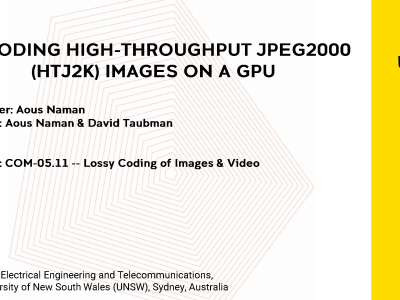Documents
Presentation Slides
ENCODING HIGH-THROUGHPUT JPEG2000 (HTJ2K) IMAGES ON A GPU

- Citation Author(s):
- Submitted by:
- Aous Naman
- Last updated:
- 2 November 2020 - 4:23pm
- Document Type:
- Presentation Slides
- Document Year:
- 2020
- Event:
- Presenters:
- Aous Naman
- Paper Code:
- ICIP2020, COM-05-11
- Categories:
- Keywords:
- Log in to post comments
High-Throughput JPEG2000 (HTJ2K) is a new addition to the JPEG2000 suite of coding tools; it has been recently approved as Part-15 of the JPEG2000 standard, and the JPH file extension has been designated for it. The HTJ2K employs a new “fast” block coder that can achieve higher encoding and decoding throughput than a conventional JPEG2000 (C-J2K) encoder. The higher throughput is achieved because the HTJ2K codec processes wavelet coefficients in a smaller number of steps than C-J2K. Moreover, the HTJ2K block coder is also more amenable to parallelizable high-speed software and hardware implementations. The HTJ2K retains most of the features and capabilities of JPEG2000, and it also supports lossless transcoding between HTJ2K and already compressed C-J2K images. Quality scalability however is more limited than C-J2K. In a recent work, we presented preliminary performance results for decoding HTJ2K images on a GPU. In this work, we present a GPU-based HTJ2K encoder; we also present early encoding results for such an encoder, showing that it is possible to encode 4K 4:4:4 HDR videos at more than 70 frames per second (fps) on a low-end card, while a high-end GPU can encode such videos at more than 400 fps.

